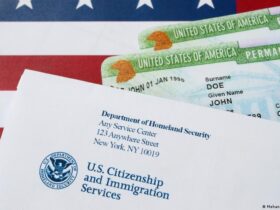China sent a replacement Shenzhou-22 spacecraft to its crewed Tiangong space station on Tuesday, ensuring the astronauts will have the means to leave the station again if necessary.
The mission, China’s first rapid emergency space launch, plugged into an 11-day span where the astronauts were aboard the station without the means to return to Earth in the event of an emergency.
What did the China Manned Space Agency say about the operation?
The China Manned Space Agency (CMSA) said the spacecraft lifted off at 12:11 p.m. (0411 UTC/GMT) on a Long March-2F rocket from the Jiuquan Satellite Launch Center in northwest China.
“The spacecraft successfully separated from the rocket and entered its planned orbit. The launch mission was a complete success,” CMSA said on its official WeChat account.
Chinese state broadcaster CCTV said the spacecraft docked at the permanently settled Tiangong space station about three and a half hours after launch.
Damage to Shenzhou-20 transport leads to gap in availability
China typically uses a rotation of two “Shenzhou” (“Divine Ark”) spacecraft to ensure that there is always a backup ship capable of returning astronauts to Earth at Tiangong Station. But that rhythm was disrupted in recent weeks.
Shenzhou-20 was supposed to bring home a trio of Chinese astronauts on November 5, but it was deemed unfit to fly due to cracks in the window caused by space debris.
As a result, CMSA was forced to deploy the only remaining airworthy ship, Shenzhou-21, to return them on 14 November. That ship leaving the station six months ahead of schedule meant that there were no flight-worthy shuttles left onboard.
The arrival of Shenzhou-22 has now closed that gap. It also contained repair parts, the goal of which was to enable astronauts to repair Shenzhou-20 for later use. It is not yet clear whether it will be possible to adequately repair it in orbit.
“This emergency launch is the first for China, but I hope it will be the last in humanity’s journey through space,” CMSA official He Yuanjun told CCTV.
Rapid mobilization of China, America to reach the Moon
According to him, Shenzhou missions typically require 45 days of preparation, but it was possible to accelerate Shenzhou-22’s launch and complete the process within 16 days, thanks in part to the ship already being based at the Jiuquan Satellite Launch Center.
The process was completed more quickly than last year, when two NASA astronauts who were supposed to stay on the International Space Station for a week had to wait nine months to return home.
The initial delay was caused by a propulsion fault in the Boeing Starliner spacecraft they were testing, and then the SpaceX mission to bring them there was also delayed.
If all goes as per schedule, Shenzhou-22 will now remain docked until April 2026, when it will return the trio of astronauts after a six-month stay.
The ship was also carrying medical supplies, spare parts for the Tiangong, and various food items for the crew. This included fresh fruit and vegetables as well as chicken wings, steak and cakes which the crew could cook using specialist equipment on board.
Both the US and China have expressed their intention to conduct a manned mission to the Moon on or before 2030 and are therefore keeping a close eye on each other’s activities.






Leave a Reply